RMS Adventure Club
- Kacie
- Oct 22, 2021
- 11 min read
When we first arrived to Bundibugyo I was asked by our team leaders to think about how I’d like to fit in to the weekly schedule at Winnie’s school. This took me by surprise. Winnie was entering Kindergarten (P1) at Rwenzori Mission School (RMS), a small schoolhouse with three rooms, two teachers, and a handful of missionary kids. The teacher to student ratio is frankly, amazing.
One side of my brain was asking “Do I have to?” while the other was hushing me and cajoling me to keep an open mind.
To be honest, the last thing I wanted to do was add another thing. I was already overwhelmed, even though we weren’t yet doing much.
I was still trying to wrap my mind around the rhythms of what our life would look like in rural Uganda. How often would I work? How often was Mike going to work? Where would Boston be on those days? How much energy does it take to cook everything by scratch? When are language lessons?
“Can I see how my weekly schedule falls into place, and get back to you on that?” I said. We had just met and I didn’t want her to think I wasn’t a team player. But I also know that I don’t do well in general if I over commit.
A short conversation ensued regarding team life and I was told that it’s pretty normal for everyone on a small team in a rural area to wear a lot of hats. This life was new to me, so I took note.
Later I told Mike, “I don’t know, it feels like too much for me.”
“That’s fine. I’ll tell them I can lead a chapel once a week.”
So we settled on that.
As the months went on and I got a better sense of what life entailed, I was glad Mike took the lead and was teaching each week. I knew a commitment to weekly teaching would have been difficult for me.
But I also started to love the kids on our team. I suddenly wanted to be a part of forming and shaping them. Winnie loved it when I was randomly at her school, and I could see how much it meant to her to have me there. I also recognized how much effort other people were putting into my kids learning, and how appreciative we were, and I wanted to reciprocate.
But how?
I tried to think a little about what would benefit the kids in their education and experience here, and what would be something that would naturally play to my strengths and schedule.
This is when I came up with: The RMS Adventure Club!
The RMS Adventure Club is a group of students who participate in carefully curated experiential field trips that seek to increase our cultural appreciation and knowledge of the people and area we live in.
I just came up with that, but I like it. The ‘carefully curated’ part makes me laugh. That is code for the reality that it usually takes 2 or 3 lengthy in-person interactions, in multiple languages, complete with cultural confusion and lots of bargaining and boundary setting, to get these planned.
I could write each of these field trips out in story form, but I think I’ll just post the basics and add 6 pictures (with captions) to give you a sense of what they have been getting to learn here in our neighborhood of Nyahuka, Uganda. I am leaving out a ton that happened in these trips so if you ever want to talk more about them let me know! I have LOVED planning and leading these and would love to help anyone brainstorm how to do this where they are at too. Just let me know! I truly believe there are adventures to be had everywhere, including right where you are.
Field Trip #1: Brickmaking
Mike and I were on a walk one day and saw a man making bricks out of mud. This is the most common way people build their houses here and a source of work for men. I thought it would be fun for the kids to actually learn the brickmaking process themselves. I also wanted them to be able to value the hard work they see people doing when we pass them by, and to understand what it takes to build a house.
When we showed up on the agreed day, our kids were really reluctant to put their feet in the mud, so I jumped in first and squished my toes around. After that they were all in! We learned a ton, got dirty, had a dip in a local river to clean ourselves up and then walked home. There will be a part II to this field when we learn how to fire the clay bricks.
Field Trip #2: Making Palm Oil
Down the street and behind our house is a place where local women gather and process palm oil. The finished product is then sold in the market place, used in local cooking. I really wasn't sure if this field trip was going to work out because I arranged it all in Lubwisi, hoping that I communicated everything correctly.
There was only one English-speaker there, a young boy about 9 years old. So this field trip was all about watching and following along.
The women emptied palm nuts (previously collected from a palm tree) into a large hand-operated grinder. The kids helped work that until the juices traveled down a drain. Then they walked down to the river and fetched jerry cans of water, pouring the water into the grinder. The end result was a sort of foam that got scooped up and put into a pot and placed over a fire. The foam boiled down into a rick red substance, what we know as palm oil.
They played in the river at the end, and we walked up to have a cabbage cooked using palm oil so the kids could have a taste.
Next up...
Field Trip #3: Exploring Semuliki National Park
I've written about Semuliki before, but our field trip there was all of our first times experiencing the place. And, we got to go with one of our newly arrived teachers- Ms. Michaela! She's the best.
Semuliki is one of Uganda's national parks and it is pretty close to our house. It doesn't get as many tourists as the other parks because you have to travel over the Rwenzori Mountains to get to it (it's remote) and it doesn't have the Big 5. But it has an interesting history (told by the guide to our students), the scalding hot, hot springs are really unique to look at, it's great for birders, it's gorgeous, and we usually see a TON of monkeys. There is a modest waterfall close-by for a fun kids hike.
Also, getting to eat hard boiled eggs that the guide makes in the hot spring water is always fun!
We learned on this field trip that when hiking through the bush it is best to wear trousers. The mosquitos were fierce anytime we stopped to look up at the monkeys swinging overhead.
Field Trip #4: Learning from Women living with disabilities
Every single field trip is a surprise. The kids show up and have no idea what is in store for the day. When they came to school on this day I introduced them to a local entrepreneur and businesswoman by the name of Sarah.
Sarah started and runs an organization to help empower local women living with disabilities. I wanted to have our kids go and visit their meeting place and hear each woman share their story. There isn't much local support for these women and it was pretty powerful and difficult to see some of them crawling down the street with shoes on their hands to come to the meeting.
It was a boundary pushing field trip and I was really proud of my students who asked great questions and listened really well, despite hearing hard stories and feeling uneasy. (I was also uneasy as Winnie had been suffering from a 105 unrelenting fever for going on 5 days- I had been at home with her the entire time until leaving the house for this field trip- and we were actually starting to plan next steps if the fever didn't subside- which it did on the eve of day 6).
Any way, back to the field trip. We heard from women who were never able to walk, some who got sick and lost their ability in late childhood, one got bit by a snake and was paralyzed. We asked them about what their lives look like day-to-day, and their challenges. All of them had kids. We heard of the injustices they faced, from getting charged more to be taken places by boda drivers to all (except 1) of them agreeing that their childrens fathers fled before the kids were born because of embarrassment of their disabilities.
My main goal of this day was to humanize the people we see around town who have disabilities. I wanted our students to be able to see beyond the exterior and know that each person has a story.
Sarah has done an amazing job creating a safe place for the women to gather. She has also taught them all how to make a living and save a little money, both of which are difficult things to do here. She is changing lives, restoring pride, and it was an honor to learn from everyone.
Also note, we received another teacher from America- Laura Marty- who is also the best. So thankful for our teachers!
Field Trip #5: Local Basket Weaving
Coronavirus hit people hard here. People without any margin in their lives then had support systems who also lost their margin. We often get people coming to our front door asking for help. We don't like to hand out money, so we are always looking for ways to keep people's dignity intact in their time of need. We are certainly not perfect, and it is our biggest challenge here: what to do at our front door. We have answered our door exhausted, annoyed, frustrated, at the end of our ropes. We have answered generously, calm, open-hearted too.
We had a woman showing up to our house although she never asked for money. Grace always had some sort of craft she had made and was asking for us to buy. Or she would arrive with a box of lemons for sale. This woman is creative and looking for ways to support herself and her family.
I asked her if she would teach our students how to make the local baskets and she said YES!
We went to her house and she explained the entire process, from picking the banana leaves, drying them, stripping them to constructing them into the beginnings of a basket.
This field trip was harder to plan because all our kids went up a grade and the span of ages and maturity levels was vast. I didn't want the little kids to struggle too much with construction of baskets and be frustrated and give up, while I didn't want the older kids to be bored. I think this was a good activity and we had enough helping hands.
*Note: I would come down with my first symptoms of Covid that evening. Thankful we took precautions and did this outside with masks (not perfectly), and no one on our team or whom we visited got sick, including Grace (who said she fasted for 3 days when she found out and begged God to keep her well).
Then we stopped by a seamstress to pick up the kids RMS Adventure club sashes (I had given them out to the students at Christmas, but we had new students who needed them). Notice them in their green sashes, which are meant to have patches sewed on after each field trip, but we've sorta fallen off the wagon on that one. It'll happen.
We ended the day down at the river, seems to be the kids favorite way to spend their time, exploring, digging up clay down there, swimming, building forts.
Field Trip #6
Part I: Pottery Women
I had all the students and our friend Joshua jump in our car and we drove out to visit a village about 10 minutes away from our house. Our main goal for this field trip was to learn how to make a clay pot. But first, I wanted the kids to see where Amina and Adihjah, our pottery teachers, lived.
When we arrived were greeted by their community and shown around. Below you will see pictures of some of what we learned about.
Top left: Piper walking by a row of mud bricks that had been made.
Top middle: Kids learning how a local dish, sombe, is made. Pictured is a jerry can for water, a bowl of cassava leaves (sombe), three rocks placed for a pot to balance atop and a fire to be made underneath, and a wooden bowl to pound the sombe in.
Top right: Looking down a very steep hill to the river far below, where the clay is dug up from and used to make pots.
Bottom left: appreciating the simplicity of a local stove
Bottom middle: walking back up from the river, note a house on the right made from local materials.
Bottom right: visiting Amina inside her house, with her end product pots in sight. Stoking the kids interest in what we are about to do, which is- drive back to the school and start with the pottery. *notice Winnie's face, there were a TON of kids behind me saying "muzungu!
muzungu!" which usually causes her to feel shy and shut down. I've course corrected for this element on field trips (crowds and being an oddity) which is why we invited the pottery ladies back to RMS and only spent a short time here.
Part II: Back at RMS, hands on learning
I am SO THANKFUL that parents are supposed to take part in some aspect of RMS, because this truly has been a highlight of living here.
We welcomed Amina and Adijah to our school. We invited them to sit down in two chairs, and gave them cups of hot chai tea. Then they told us their story. They started making pots about the age of our students, before there were plastic buckets available and everyone used clay. They've been doing this ever since.
We had two interpreters (also our friends) present and we played an impromptu game I made up called: respecting your elders. The students learned 1 very specific way children respect their elders here. It is by helping them out whenever they ask you to get them something. You don't talk back, you just do it.
We were told that the elder doesn't even need to speak, they can just meet a young persons gaze and then direct them to an object they want, and the younger person will run and grab it for them.
So that's what we did.
Our kids looked up as the elders looked around at objects, then the kids would run and grab whatever they believed they wanted and bring it back to them.
The students learned how to properly give objects (on their knees with their arms lifted up and out) and receive objects. We learned a few new words in Lubwisi too (most field trips we try to incorporate in a little language learning too)
Then we moved on to the super fun part- making pots with ebumba (lubwisi for clay). We even let our preschoolers join us on this part because clay is fun for all ages!
We asked the women what they usually do when they make a monaga (pot), and they said: tell stories and sing.
So I leave you with that, a song called "Kahuka kambonabonia". It was explained that the translation is "the insect has made me suffer", but that the meaning is: poverty is like an insect that keeps disturbing you. They gave the example of being out farming and a fly keeps biting your back and won't get away from you.
When I asked our students if they knew what the word "poverty" meant, they said no. It was an interesting moment for me, to see everyone in front of me, sharing the same space but having completely different realities. Which, is exactly the point of these experiences. To broaden our awareness of where we live, to expand our hearts, to learn how to do and make things we've never done or made before, to meet people we've never met before and to learn from them. So we explained poverty to them as 'not having enough of what you need' and then the women sang us their beautiful song.
(Notice how one of them swats her back during the song, acting out what she is singing.)
Proof of life: I finally got in a picture!






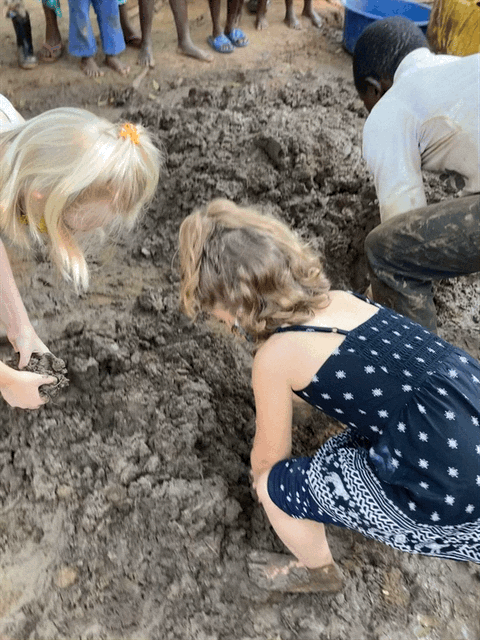















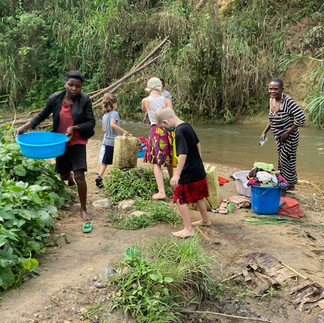

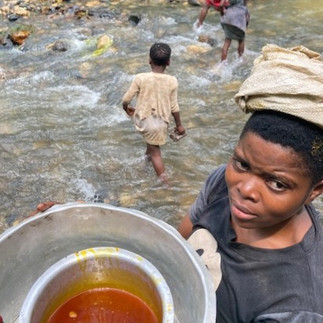

























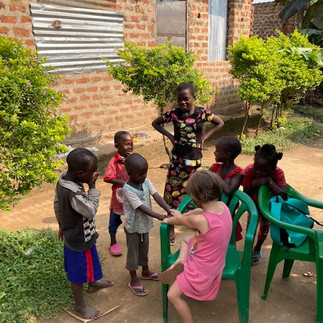









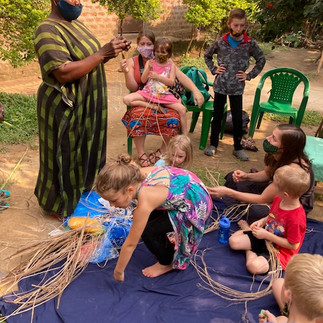





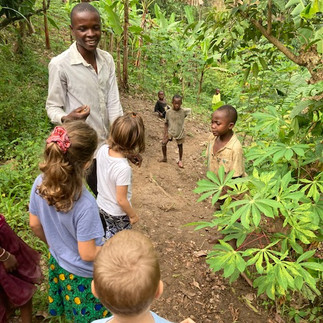

































Comments